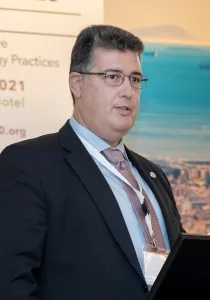
Observer
Dr Constantinos Loupasakis is a Professor at the school of Mining and Metallurgical Engineering of the National Technical University of Athens (NTUA) with expertise in Engineering Geology and Geotechnical Ground Improvement Technics. Also, he acts as contracted Professor at the School of Science and Technology of the Hellenic Open University (HOU) and at the Technical Education School of the Corps of Engineers of the Hellenic Army. He is the Director of the post graduate education program “Natural Catastrophic Events under Climate Change Impact“ of the HOU. He has been the President of the Greek National Group of the Engineering Geologists of the International Association of Engineering Geology (IAEG) since 2018. Dr. Loupasakis has received a Ph.D. in Enginering Geology – Geotechnical Engineering (2002), a Diploma in Civil Engineering, (2001), a MSc Diploma in Applied and Environmental Geology (1998) and a Degree in Geology, (1995), from the Aristotle University of Thessaloniki (AUTH), Greece. He has an extensive research experience since 1996 working, with overlaps, as Researcher at the Geology Department of AUTH, as Self-Employed Geologist and Civil Engineer, as an Engineering Geologist at the Institute of Geology & Mineral Exploration of Greece, as Visitor Assistant Researcher at the Department of Natural Resources and Natural Hazards of the Technical Research Center of Crete, and finally as a Professor at NTUA. He has participated in more than 50 research projects and studies as coordinator, principal investigator or co-investigator. He also has an extensive teaching experience since 1996, teaching Engineering Geology, Soil Mechanics, Rock Mechanics, Ground Improvement Techniques, Hydrogeology, Underground Water Management, Foundation Engineering and Environmental Geology. In regards to the study of land subsidence phenomena, his research interests are focused mainly on the investigation of phenomena related to the overexploitation of aquifers, to the mining induced subsidence and to the oxidation of organic soils. In the majority of his studies the ground truth data (geological, geotechnical and hydrogeological data) have been used for the validation of InSAR remote sensing data. Dr. Loupasakis has published more than 120 Papers in scientific magazines and in congress proceedings, 6 Scientific– educational books and more than 50 Technical reports.
- Loupasakis C., Rozos D., (2009), Land Subsidence Induced by Water Pumping in Kalochori Village (North Greece) – Simulation of the Phenomenon by Means of the Finite Element Method, Quarterly Journal of Engineering Geology and Hydrogeology, Geological Society of London, v. 42, No. 3; pp. 369-382.
- Raspini F., Loupasakis C., Rozos D. and Moretti S. (2013) Advanced interpretation of land subsidence by validating multi-interferometric SAR data: the case study of Anthemountas basin (Northern Greece). Nat. Hazards Earth Syst. Sci., 13, 2425–2440.
- Loupasakis C., Agelitsa B., Rozos D., Spanou N. (2014) Mining geohazards—land subsidence caused by the dewatering of opencast coal mines: The case study of the Amyntaio coal mine, Florina, Greece. Natural Hazards, Springer, 70:675–691, https://doi.org/10.1007/s11069-013-0837-1
- Svigkas N., Loupasakis C., Papoutsis I., Kontoes Ch., Alatza St., Tzampoglou Pl., Tolomei Ch., Spachos Th. (2020) InSAR campaign reveals ongoing displacement trends at high impact sites of Thessaloniki and Chalkidiki, Greece. Remote Sens. 2020, 12, 2396; https://doi.org/10.3390/rs12152396
- Kamali M., Papoutsis I., Loupasakis C., Abuelgasim Ab., Omarid K., Kontoes Ch. (2021) Monitoring of Land Surface Subsidence using Persistent Scatterer Interferometry Techniques and Ground Truth Data in Arid and Semi-Arid Regions, The Case of Remah, UAE. Science of the Total Environment, 776 (2021) 145946, https://doi.org/10.1016/j.scitotenv.2021.145946
